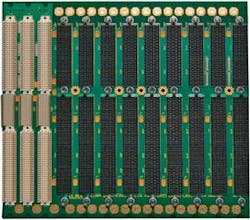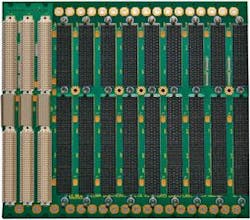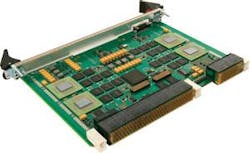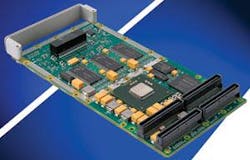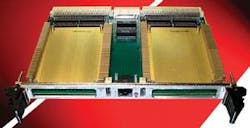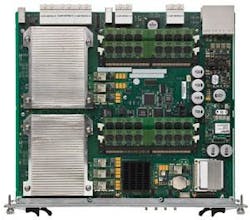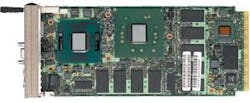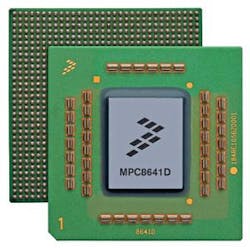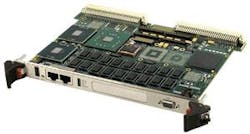Computational complexity
Single-board and mezzanine-board computers deliver expanded functionality in a reduced size.
By Courtney E. Howard
Military and aerospace systems designers who use single-board computers (SBCs) are looking for the latest commercial technologies, while also taking into account the unique needs of defense applications. End users want ever greater embedded processing power, but lower power consumption. They require fast performance, but also a low-heat design. They need more memory capacity, but in less space and at low cost. They seek high performance, high density, flexibility, extended capabilities, I/O and peripheral options, and ruggedization—neatly wrapped in a small form factor. In short, military systems integrators are endeavoring to pack as much technology as they can on as small a device as possible.
“The industry wants more powerful compute solutions with less power draw and a nominal power increase from existing technology,” says Jason Smith, product marketing manager, Intel SBC platforms in Santa Clara, Calif. “The push is definitely for more compute power in rugged solutions that draw less power than existing designs and supported by the latest operating systems.”
It is not surprising, then, that military systems integrators seek to implement multicore CPU technology, which delivers strong processing power, but consumes relatively little power. Opposed to one high-powered core that does everything, multicore processors employ several low-power cores that perform tasks simultaneously—a process called symmetric multiprocessing (SMP). Increasingly, military and aerospace users are employing multicore CPUs in PowerPC and Intel platforms with a focus on size, weight, and power (SWaP) performance, says Smith.
“For years, the PowerPC has been the dominant processor in the 6U VME SBC market,” notes Arlan Pool, fellow and technical director of defense business development at Mercury Computer Systems in Chelmsford, Mass. “Now, more Intel-based SBCs are emerging, such as the further adoption of the Intel x86 architecture.”
With these trends in mind, engineers at Curtiss-Wright Controls Embedded Computing in Leesburg, Va., and Intel crafted the SVME/DMV-1901 Intel Core2 Duo SBC to deliver heightened performance in one slot. The 1901 board is 6U VME320, Intel 64-bit Core architecture with onboard ATI video and LSI SCSI. It boasts two PMC sites, one of which supports 4xPCIe XMC, and several I/O options, including USB, Gigabit Ethernet (GigE), and RS232/422 serial channels. The product line incorporates Level 0 air-cooled through rugged Level 200 conduction-cooled models.
Intel will continue to support the mil-aero market with new advances in computing technology, including a roadmap to quad-core single-package processors, and packaged commercial off-the-shelf (COTS) solutions, Smith says.
“Platform processors are definitely the industry trend,” says Mark Slonosky, PowerPC SBC product marketing manager at Curtiss-Wright. “Multicore platform processors, like Freescale’s 8641 [Freescale Semiconductor in Austin, Texas] and P.A. Semi’s 1682 [P.A. Semi Inc. in Santa Clara, Calif.], are allowing COTS vendors to create very powerful solutions, providing in some cases very compelling SWaP solutions.”
More in less space
“SWaP is always on the forefront of the minds of military/aerospace systems integrators,” admits Mercury’s Pool. “With the new high-performance multicore processors, the SBCs now have the capability to perform computation, in addition to the typical control and I/O processing. The increasing density of flash memory will enable significantly larger applications and datasets to be stored on-board—reducing the requirements for disks.”
Single-board and mezzanine-board computers should not only support the current generation of processors with several cores, but also accommodate an increased number of integrated peripherals, such as Gigabit Ethernet, and interfaces like PCI Express and sRIO, Pool says. “The more performance, functionality, and peripherals that can be integrated on a single board, the more attention it will gain in the marketplace. In addition, rugged environmentals—extended temperature, shock, and vibration—are important in almost every application.”
Mercury engineers introduced the company’s Momentum Series VX6-200, a multicore SBC with two dual-core Intel Xeon processors. Available with dual-core processors in a single- or dual-processor configuration, the device supports up to 4-way SMP. SMP support provides significant performance advantages for compute-intensive applications, while requiring minimal porting, says Martin Vasquez, Mercury’s regional manager of modular solutions. The VX6-200 has a PMC/XMC mezzanine for high-speed I/O modules, and it is available in conduction- and air-cooled rugged versions.
In addition to the advent of multicore processor technology, today’s mil-aero devices are benefiting from the launch of the VPX platform. “The Intel SBC 6U industry is moving to L100 rugged air-cooled for certain technology refresh opportunities through full rugged L300 conduction-cooled VPX and VPXredi line-replaceable modules,” Smith says. Intel’s mil-aero customers are not the only ones, either.
“In the distant past, the vast majority of Mercury’s VME systems used either FORCE SPARC-based SBCs with Solaris [Sun Microsystems in Santa Clara, Calif.] or Motorola PowerPC-based SBCs with VxWorks [Wind River in Alameda, Calif.],” Pool acknowledges. “Now, the SBC marketplace is much more fragmented with a variety of standards, form factors, and functionality.” One such standard is garnering interest amongst original equipment manufacturers (OEMs) and end users alike.
Last October the American National Standards Institute (ANSI) in Washington ratified the VPX base standard under ANSI/VITA 46.0-2007 and the VMEbus Signal Mapping for VPX under ANSI/VITA 46.1- 2007.
VPX is a specification of VITA, the trade association in Scottsdale, Ariz., dedicated to fostering accredited, open-system architectures in critical embedded system applications. “VPX is the latest backplane standard from VITA targeted to specifically address the needs of critical embedded systems, including industrial control, medical, and aerospace applications,” says a representative. “The VPX standard addresses both the 6U and 3U form factors, the latter of which is becoming more important as integrated components enable system sizes to shrink.”
3U & 6U form factors
System size continues to be a leading concern with many military and aerospace systems integrators, who want to pack more into the same space at equal or lower power, acknowledges Curtiss-Wright’s Slonosky. “Newer platform processors, such as the P.A. Semi 1682 and Freescale 8641, are enabling COTS providers to provide more processing power for less power consumption in all the popular form factors,” he says. At the same time, “3U solutions are growing in popularity, and the emergence of multicore, lower-power, platform processors provides a very powerful value position.”
Curtiss-Wright has unveiled a P.A. Semi-based 3U VPX3-125 SBC and an XMC/PMC carrier card, the VPX3-215. The VPX3-125 provides high-speed, serial off-board fabrics, dual processing cores, and dual memory banks, in addition to I/O flexibility when combined with the VPX3-215 carrier, to deliver a power solution for SWaP-constrained applications, such as mission computers, vetronics, and software-defined radios.
The trend is shifting away from the 6U VME SBC to 3U and 6U VPX (VITA 46/48) and 6U VXS (VITA 41) SBCs, notes Pool. “With increased power and newer components, SBCs have significantly more performance and functionality than previous generations. The latest devices now allow the type of functionality and performance that was typical of 6U SBCs to be integrated into a 3U SBC.”
New industry standards help contribute to this success. VPX, for example, offers a greater number of I/O pins than previous versions which can be used for I/O to the backplane from the mezzanine sites. A lack of I/O pins to the backplane created challenges in the past for VME SBCs. Additionally, “the new generation of SBCs are now fabric-enabled, supporting interconnect fabrics, such as 1- and 10-Gigabit Ethernet, serial RapidIO, and PCI Express,” Pool says. “For the most part, the VME SBCs were limited to the VME bus to communicate with the rest of the system, creating a bandwidth bottleneck. The mezzanine boards are no longer bandwidth-constrained to PMC’s PCI interface. We are seeing XMCs with sRIO and PCI-Express with higher bandwidths, so systems are less prone to bandwidth bottlenecks.”
VPX adoption
Technology firms and product engineers are rapidly adopting the latest industry standards, including VPX and XMC (VITA 42). XMC, as described by VITA, is an open standard for supporting high-speed, switched interconnect protocols on the PMC form factor.
Ross Q. Smith, chief executive officer of Quantum3D Inc. in San Jose, Calif., and his customers are part of the movement toward VPX and XMC. “Both provide greater performance, improved networking and signal integrity, and enhanced power-handling capabilities—all of which are essential for next-generation performance levels that are required by new, extended-environment backplane-based systems.”
Quantum3D is developing a family of COTS VPX-based SBCs, as well as a number of different XMC video capture, advanced graphics, and digital signal processing (DSP) products for release this year. The company already has won contracts for airborne and ground vehicle VPX-based systems and XMC-based graphics, signal processing, and video subsystems.
When it comes to military and aerospace applications, product managers at GE Fanuc Intelligent Platforms in Charlottesville, Va., are focusing on VPX solutions as the best way of providing high-performance computing for future rugged environments. “We fully expect VME and CompactPCI to continue in production for some years, but VPX is the platform of choice for many new design-ins,” says Richard Kirk, GE Fanuc’s global product manager for single-board computers.
Today’s multicore processors from Intel, Freescale, and P.A. Semi are ideal technologies for VPX solutions, Kirk mentions. “VPX allows us to get the very most from these architectures in terms of data bandwidth within and between boards. Most of our VPX boards also support XMC mezzanine technology; although there are not many XMCs available right now, we believe there will be in the near future.”
GE Fanuc offers several COTS 3U VPX products, including Intel- and Freescale-based SBCs and high-performance graphics solutions. “This is opening up the embedded training market where small form factors and highest possible graphics performance are required.”
The company’s product engineers are also investigating system-on-a-chip (SOC) technologies. SOCs integrate virtually all components of a computer or electronic system—such as digital, analog, mixed-signal, and radio-frequency functions—into one integrated circuit.
“SOC solutions are useful to board vendors as they tend to consume less board real estate than discrete solutions, but they also present a challenge in terms of cooling technology—as they focus more heat into a small footprint,” says Kirk. “VPX and XMC allow the maximum performance to be extracted from fabric-based SOC devices and therefore is the pathway to the future.”
Ruggedization required
Another industry specification gaining industry attention is MicroTCA (MicroTCA R1.0) from PCI Industrial Computer Manufacturers Group (PICMG), a consortium of more than 450 companies who collaboratively develop open specifications for high-performance applications in Wakefield, Mass.
The open COTS specification MicroTCA is the greatest SBC and mezzanine-board computer technology today according to Jeff Durst, program director, processors, embedded computing, at Emerson Network Power Connectivity Solutions in Bannockburn, Ill.
A low-cost backplane specification, MicroTCA leverages AdvancedMC mezzanine boards from Advanced Telecom Computing Architecture (AdvancedTCA) by using them as SBCs plugged directly into a backplane. As a result, no carrier is required, which in turn directly improves cost and thermal performance in a smaller footprint. Also beneficial to engineers and end users is the flexibility of MicroTCA, equipped to accommodate the latest processors and interfaces, next-generation wireless networks, and the most demanding high-availability applications, Durst explains.
Durst and colleague Clayton Tucker, senior marketing manager of embedded computing at Emerson Network Power, have noticed that open standards used in the telecommunications market are directly influencing industries traditionally associated with COTS products, including defense and aerospace. Military and aerospace systems integrators are interested in the ability to work with networked topology platforms that take advantage of the many advances in COTS standards in telecommunications, they say. “Until recently, this has not been an option, due to cost-prohibitive issues and the fact that these platforms have not been rugged enough to accommodate military and aerospace applications,” Durst explains. “It became apparent that in order to meet these needs, it was crucial to create a ruggedized version of the MicroTCA standard.”
Rugged MicroTCA will have a big role in single-board and mezzanine board computers, predict Durst and Tucker. “We anticipate that this new version of the MicroTCA standard will be able to effectively address the shock and vibration, EMC [electromagnetic compatibility], temperature, and I/O conditioning required to operate in demanding application environments.”
Durst and Tucker are not alone in their perception that network topologies are the hottest mil-aero applications for SBCs and mezzanine-board computers today. The new networked topologies have been designed with multicore processors, Ethernet and next-generation Ethernet connectivity (1GigE and 10GigE), system management, and flexible packaging options.
“With this thrust toward modern, open-standard system platforms, various advantages such as configuration management, reliability, operating environment, lifecycle management, and interoperability are inherent to the intelligent platforms designs approach,” Durst says. “MicroTCA and AdvancedTCA are primary examples of next-generation platforms which will have a range of advantages that various technologists and engineers are just now adapting and adopting.”
Engineers at Emerson harnessed AdvancedTCA in the company’s two new COTS products: the PrAMC-7210 processor module and the ATCA-9301 processor blade. Powered by an Intel Core 2 Duo processor core, the PrAMC-7210 is designed to the AdvancedMC specifications, making it suitable for AdvancedTCA carriers and MicroTCA-based applications requiring high availability, scalability, manageability, and low cost. The PrAMC-7210 is a fit for processor-intensive applications that require not only fast data transfers based on Gigabit Ethernet or PCI Express interfaces, but also multicore processing performance. For high-throughput, high-compute applications, the ATCA-9301 is a 10-gigabit ATCA processor blade with two many-core Cavium OCTEON 16-core processors. Emerson Network Power’s offerings support layer 4+ content processing/switching and high-performance security applications.
Hardware-enabled security
Embedding standards-based security into SBCs is another emerging technology trend. Given the growing need to protect data at rest and in motion, technology companies and end uses in military and aerospace environments are investigating hardware-enabled encryption, decryption, and authentication.
Mil-aero systems integrators are increasingly requesting hardware-based security using AES/3DES with authentication using MD5/SHA, as well as National Security Agency (NSA) Type 1 cryptography, notes Nauman Arshad, a product marketing manager at Curtiss-Wright.
The company released PMC-110 CryptoNet, a mini-SBC on a PMC with built-in hardware crypto engines, a Freescale 8555E processor with built-in security, 2 GigE, and 1 serial port. Combined with the right set of software, says Arshad, the new product has two main uses. One application is a basic VxWorks BSP (board support package) that enables users to leverage the hardware-enabled crypto engines and write their own security application.
Another application involves the PMC site of a router, such as the Curtiss-Wright VPX6-684 FireBlade. The PMC-110 uses Enhanced Security Software (ESS) to provide network security, via firewall, network address translation (NAT), Internet Protocol Security (IPSec), Internet Key Exchange (IKE), virtual private network (VPN), and crypto. “A user simply accesses this PMC through a management interface where he can configure the various network security settings to protect the Gigabit Ethernet port that provides an interface to the external network,” Arshad explains.
“The PMC-110 running a firewall on the router can be used to set up de-militarized zones on the network,” Arshad continues. “The NAT software feature running on the PMC-110 can provide IP masquerading, whereby external nodes or users on the network see a publicly assigned IP address, but behind the NAT/firewall, the system has privately assigned internal IP addresses.” The hardware-enabled crypto engines, combined with the crypto configuration API, enable users to select a hardware-enabled encryption/decryption algorithm and an authentication algorithm to protect data in motion.
According to Arshad, security will be ubiquitous in the future. Security processor mezzanine boards will evolve to include multicore SoCs with increased GbE interfaces, until it “maxes out” the PMC connector, he says. These cards will then leverage XMC connectors and serialized 1 and 10 GbE interfaces. “Increased security features will need to be hardware assisted—e.g., IPSec and TLS [Transport Layer Security] protocols—to ensure decent performance, because running protocols like these purely in software will be too slow. Another key trend is increased security certification.”
Integration imperative
Security measures—whether through hardware, software, procedures, or a combination of these elements—reduce risk to mil-aero end users, such as warfighters.
“Because of increasing complexity and density of both components and boards, customers are looking for realistic strategies to reduce risks for system integration and software development,” explains Rodger Hosking, vice president of Pentek Inc. in Upper Saddle River, N.J. “Often, they prefer to buy a subsystem already integrated and characterized, rather than individual board-level products. Specialized environmental requirements driven by each application, along with the appropriate qualification tests, are becoming more common.”
Hosking cites a recent Pentek airborne reconnaissance data-recording system as an example. The most critical parameters were the flexible control of signal bandwidths, high data rates, and large storage capacities, coupled with a need for high reliability and challenging environmental and crash safety requirements. The system necessitated a combination of mezzanine modules and carrier boards in a ruggedized enclosure—requirements now typical of many deployed military systems.
Pentek in January introduced its Model 4207 I/O processor, a single-board VME/VXS computer with a dual-core Freescale MPC8641D processor, dual PMC/XMC mezzanine sites, a Fibre Channel controller, dual optical serial ports, dual Gigabit Ethernet ports, and a Xilinx FPGA. Its fabric-transparent gigabit serial crossbar switch supports SerialRapidIO, PCI Express, Fibre Channel, Aurora, and other protocols. Native SerialRapidIO and PCI Express on the MCP8641D processor free the FPGA for signal processing tasks.
“Gigabit serial fabric connectivity between system boards and modules and implementation of compute-intensive algorithms in FPGAs are the two major technology drivers for real-time systems,” Hosking says. “High data rates between components—processors, memory, and peripherals—increasingly favor highly integrated solutions like SOC. For board-to-board and system-to-system connectivity, the maturing of emerging embedded computer standards for switched gigabit serial fabric, along with the supporting software infrastructure, will ensure this interconnect technology in future systems.”
Model 4207 uses industry standards throughout its architecture, so it is well suited to such high-performance applications as radar, communications, wideband recording, signal intelligence, electronic countermeasures, data acquisition, and telemetry.
Strength in the future
“The future will bring next-generation devices and interfaces to SBCs,” says Mercury’s Vasquez. As examples he cites: moving from the current Gigabit Ethernet at 1 gigabit/second to 10 Gigabit Ethernet at 10 gigabits/second, the multicore CPU trend, and the increasing density of flash memory enabling significantly larger applications and datasets to be stored on-board.
“Technology is allowing more to be done with less, which in all form factors will drive a reduced footprint for processing power,” says Curtiss-Wright’s Slonosky. He predicts a continued demand for legacy form factors, such as VME and CPCI, considering that not all applications will require the increased bandwidth offered by VPX solutions and fabric interfaces. Nonetheless, switched-fabric interfaces and VPX solutions will grow in popularity, and legacy I/O such as 1553 and serial ports will still be demanded. “Even though processes will decrease in size, space taken by these legacy I/O will not.”
Quantum3D’s Smith predicts increased requirements for technology insertion, in an effort to avoid component obsolescence, at the SBC and mezzanine level, “whereby customers can upgrade their COTS systems by inserting refreshed, software compatible SBCs and XMCs.” Prime contractors tend to leave component-level decisions, such as SOCs, in the hands of subsystem developers.
“The interfaces seem to be stable for the next few years, with PCIe and switched fabrics like GigE, 10GigE, RapidIO, and Infiniband providing the foundation for the next decade or so,” continues Smith. “We see increased momentum for Windows—believe it or not—in non-real-time applications; and Linux is becoming very dominant in real-time C4ISR [command, control, communications, computers, intelligence, surveillance, and reconnaissance] and C2 [command-and-control] applications, and many mission processing applications.”
The widespread adoption, acceptance, and longevity of the latest industry standards and technologies remain to be seen. Perhaps only time will tell. For now and the foreseeable future, mil-aero end users, industry standards organizations, technology vendors, and government organizations continue advancing products, applications, and the industry in general.
“The proportion of defense spending allocated to technology of this kind is ever increasing,” says Kirk. The future is exciting for high-performance computing.
Mil-aero requests
Topping military and aerospace customer requests and requirements are the following, says Jason Smith, product marketing manager, Intel SBC platforms.
- SWaP
- RoHS/lead-free, or a roadmap to get there
- Rugged SBC, DSP, and X/PMC boards that are COTS and delivered with reasonable lead times
- Higher capacity and faster performance for onboard SBC and mezzanine flash storage
- High-performance video solutions
- Larger RAM sizes
- Multicore processors
- Real-time operating systems
